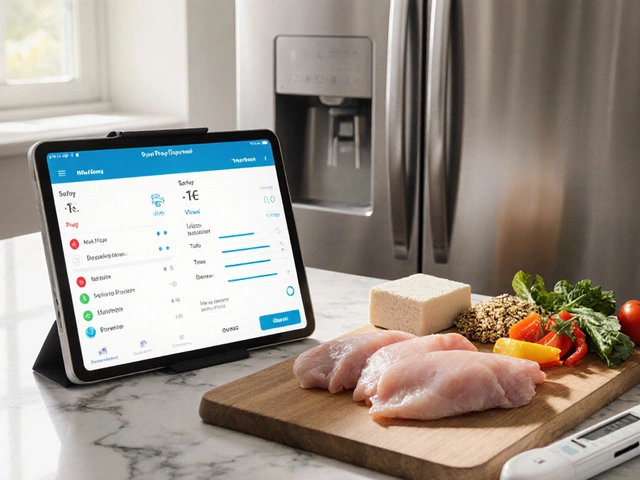Ever looked at your workout mat and wondered, should I hit it before or after breakfast? Some folks swear by exercising on an empty stomach, claiming it supercharges fat burning. But is there more to this than just burning calories?
There's a bunch of science-y stuff behind this. When you exercise without eating, your body might tap into fat stores quicker. That's a win if you’re aiming for weight loss, right? But hold up—it could also mean low energy levels, which might not be everyone's cup of tea.
And let's not forget everyone's body reacts differently. What leaves one person feeling like a rockstar may leave another feeling dizzy and reaching for the peanut butter. Understanding how your body works can make a big difference.
- The Science Behind Fasting and Exercise
- Pros of Exercising on an Empty Stomach
- Cons of Fasting Workouts
- Best Home Workout Equipment
- Tips for Safe Fasting Workouts
- Finding What Works for You
The Science Behind Fasting and Exercise
So, what’s really happening when you work out on an empty belly? When your body is in a fasted state, it doesn’t have immediate access to carbohydrates for energy. This means it might turn to fat as the next best energy source. Sounds good if you're eyeing those skinny jeans, right?
This process is called fat oxidation, and it can be super efficient for those looking to shed some pounds. But here's the catch—our bodies are like picky machines. If you're lifting heavy weights or doing high-intensity interval training, you might find your performance dips without those pre-workout carbs.
There’s also the matter of insulin levels. Exercising while fasting might improve insulin sensitivity, which is just a fancy way of saying your body gets better at using insulin to lower blood sugar. That's a plus for both weight management and overall health.
But—and it's a big but—not everyone experiences these benefits. Some people might feel light-headed or less motivated without food. It’s kind of a balancing act, really. You have to find what keeps you energized and ready to tackle that workout mat.
| Workout Type | Fasted Benefits | Fed Benefits |
|---|---|---|
| Cardio | Increased fat burn | More energy |
| Strength Training | Improved insulin sensitivity | Better performance |
Ultimately, the choice between fasting and eating is a personal one. Some love the boost from a fasted morning workout, while others prefer fueled up sessions. It's all about what makes you feel good and helps you stay consistent. Listen to your body—it's usually got a pretty good idea of what's best for it!
Pros of Exercising on an Empty Stomach
Alright, let’s talk about why some folks like to get on with their workouts before having breakfast. One of the biggest things you’ll hear is about fat burning. When you exercise on an empty stomach, your body might just dip into those pesky fat stores for energy instead of using the food you haven’t eaten yet.
This approach can be quite appealing if weight loss is your goal. It’s called fasted cardio, and some say it helps them see results faster because fewer carbs are available, prompting the body to burn fat. Sounds cool, right?
There’s some support from science, too. A study in 2017 found that participants who exercised before breakfast burned almost 20% more fat compared to those who didn’t. That’s something to think about if you’re in the game for the fat-burning benefits!
"Fasted workouts can enhance your body's ability to burn fat, especially when performed consistently over time," says Dr. Kevin Norton, a respected sports scientist.
Another pro is the simplicity and time-saving factor. If you exercise first thing, you’re done with your workout before your day really kicks off. That’s a big plus for busy bees! Plus, having an empty stomach could mean less bloating and digestive discomfort during intense workouts.
Bottom line: Morning workouts on an empty stomach might help you burn fat efficiently. Just make sure you're tuned into your body and know when it's working for you—or not.
Cons of Fasting Workouts
Before you decide to skip breakfast and jump straight into your morning workout routine, consider the potential downsides of exercising on an empty stomach. While some find it effective, there are some noteworthy pitfalls that can't be ignored.
First up, there’s the risk of running out of steam. Without fuel, your energy levels might plummet faster than a smartphone battery on YouTube. This can make workouts feel tougher and might even lead to cutting sessions short. If your goal is to build muscle, this lack of energy might hinder those gains. Your body needs fuel to power through intense workouts!
Another concern is how fasting workouts can mess with blood sugar levels. Dropping blood glucose could leave you dizzy or lightheaded. Not cool, right? For someone dealing with issues like diabetes, it might even be risky. Safety first, always!
- Low Energy Levels: Might affect workout intensity and duration.
- Blood Sugar Swings: Risk of dizziness or feeling faint.
- Muscle Loss: Your body might break down muscle for energy.
Exercising with no food in the tank can also increase stress hormones like cortisol. Long term, this could play a role in storing fat rather than losing it, which is kind of the opposite of what we want.
And don’t forget, we’re all unique snowflakes when it comes to fitness and health. What works for Derek might not work for everyone else. It's all about finding what makes you feel like your best self while staying safe and healthy.

Best Home Workout Equipment
Setting up a home gym can be a game-changer for sticking to your workout routine. Whether you prefer a morning workout or an evening sweat session, having the right gear can make all the difference. Let's break down some must-have equipment that brings the gym to you.
Resistance Bands: These little lifesavers are perfect if you’re short on space and want something versatile. Resistance bands offer a full-body workout and can help build strength and flexibility without needing heavy weights. Plus, they're affordable and easy to stash away when not in use.
Dumbbells: A staple in any home gym, dumbbells are essential for strength training. They come in various weights and are ideal for exercises targeting arms, chest, back, and even legs. Adjustable dumbbells are a smart choice if you want to save space while still having a range of options.
Exercise Mat: Whether it's yoga, Pilates, or just stretching, a good exercise mat provides cushioning and support. Look for one that's thick enough to protect your joints but also grippy enough so you don’t go sliding around during your workout.
Jump Rope: Don't underestimate the power of a jump rope. It's one of the cheapest and most effective tools for cardio. You can burn a ton of calories, improve coordination, and increase your heart rate in just a few minutes.
Stability Ball: These are great for core workouts and improving balance. Use it for exercises like crunches, planks, or as a bench for dumbbells to add an extra challenge.
If you're curious about stats, here's a quick comparison:
| Equipment | Average Cost | Space Needed |
|---|---|---|
| Resistance Bands | $10-$50 | Low |
| Dumbbells | $30-$300 | Medium |
| Exercise Mat | $20-$100 | Low |
| Jump Rope | $5-$20 | Low |
| Stability Ball | $15-$50 | Medium |
Investing in home workout equipment is a smart move. It helps you stay consistent without the hassle of a gym commute. Plus, it gives you the flexibility to choose when and how you want to exercise. And remember, it's all about what works for you and fits your space, routine, and budget.
Tips for Safe Fasting Workouts
So, you're thinking of giving this exercise on an empty stomach thing a shot? Cool! But let's make sure you're doing it safely. Fasting workouts can be awesome, but only if you listen to your body and take a few precautions.
First, start slow. If you're new to this, don't dive into a super intense session right away. Begin with something easy, like a brisk walk or light yoga. This helps your body get used to the idea of moving without food.
- Hydrate Like a Boss: Water is your best friend here. Your body might be missing breakfast, but it definitely needs water to keep everything running smoothly.
- Keep Snacks Handy: Just in case you start feeling light-headed or hungry mid-workout, have a quick snack like a banana or a handful of nuts nearby. Better safe than sorry!
- Focus on Form: When pushing through a fasting workout, it's crucial to maintain good form. This prevents injuries and helps you get the most out of your session.
Be mindful of your body's signs. Feeling dizzy or sick isn't a badge of honor. It's your body's way of saying 'Hey, I need a snack or maybe just a rest.' Listen to it! And if you're using home workout equipment, make sure you've got enough space and everything is set up safely.
Now, if you're looking at making this a regular thing, you might want to check in with a professional or your doctor, especially if you have any health conditions. They can give you the green light or suggest tweaks that suit you.
Lastly, don’t pressure yourself. Some days, your body might just not be up for a fasting workout. That's alright. Fitness isn’t a one-size-fits-all deal. Do what feels right for you today.
Finding What Works for You
So, you're all geared up to make the best choice for your workout routine. Whether you go for a fasting workout or not, what matters most is finding what suits your body and lifestyle. Here's some practical advice to help you figure things out.
First off, consider your goals. If your main aim is to burn fat, trying out exercise on an empty stomach might be worth a shot. Research shows that exercising in a fasted state can increase fat oxidation. However, if you're into building muscle or improving performance, having a small meal or snack before hitting the gym might be a better approach. A protein shake or a banana could provide the energy boost you need.
Next, pay attention to how your body responds. Listen to its signals! Feeling faint or overly tired during a workout? That’s a sign you might need to fuel up beforehand. On the flip side, if you're feeling energetic and light, maybe fasting is your jam.
It's also crucial to look at your schedule. If mornings are hectic and grabbing breakfast just isn’t doable, morning workouts on an empty stomach could be practical. But if you can spare 20 minutes for a quick bite, even better.
Here’s a simple experiment: try switching between fasted and non-fasted workouts. Keep track of how you feel, maybe jotting down notes on energy levels, mood, and performance. After a couple of weeks, review your notes to spot any patterns or preferences.
Beyond that, choose the right equipment that fits your workout preferences, especially if you're a fan of home fitness. Here's a look at some reliable options:
- Resistance bands: Great for strength workouts without needing lots of space.
- Dumbbells: Perfect for versatility and variety in home workouts.
- Yoga mat: A must-have for exercises, stretching, or yoga sessions.
Every body’s different, so what’s vital is tuning into yours. Mix and match, see what sticks, and soon enough, you’ll have a workout routine that feels completely spot on!





